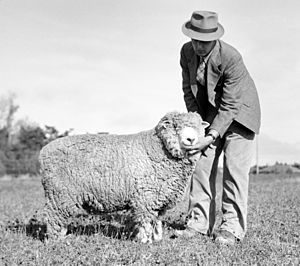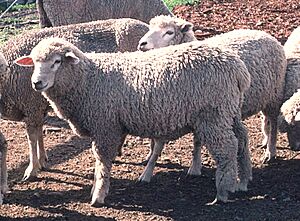Corriedale facts for kids
Corriedale sheep are a special type of sheep. They are known as a "dual purpose" breed. This means they are raised for two main things: their wool and their meat.
Corriedales are the oldest crossbred sheep breed. They were created by mixing two other breeds: the Merino and the Lincoln. This happened around the same time in both Australia and New Zealand. The first Corriedale sheep came to the United States in 1914. Today, you can find Corriedale sheep all over the world. They are farmed in Australia, New Zealand, the United States, Southern Brazil, Uruguay, and Patagonia. They are very popular in Uruguay. On the Falkland Islands, Corriedales and Polwarths are the main types of sheep.
Contents
What Makes Corriedale Sheep Special?
Corriedale sheep live a long time. They are also very tough and can handle many different weather conditions. These sheep are calm and easy to care for. Female Corriedales are good mothers and have many lambs.
They are large sheep with a broad body. They are also "polled," which means they do not have horns. Corriedales produce a thick, fluffy fleece (wool). This wool is popular for making yarn and clothes. Their wool is medium-fine, long, and soft.
Wool and Meat Quality
Corriedale wool is bulky and high-quality. It usually measures between 25 and 30 microns thick. A grown female sheep's fleece can weigh from 10 to 17 kilograms (22 to 37 pounds). The wool fibers are usually 9 to 15 centimeters (3.5 to 6 inches) long. After cleaning, about 50 to 60% of the raw wool weight remains.
Adult male Corriedale sheep can weigh from 79 to 125 kilograms (175 to 275 pounds). Female sheep can weigh from 59 to 82 kilograms (130 to 180 pounds). Their lambs grow well and provide good quality meat. Their skins (pelts) are also valuable.
How Were Corriedale Sheep Developed?
The Corriedale breed was developed in Australia and New Zealand. Breeders carefully crossed Merino and Lincoln sheep. They also chose the best sheep to continue breeding. The main goal was to create a sheep that could live well in drier areas. They also wanted a sheep that produced long, good quality wool.
The Creator of the Breed
A man named James Little was the first breeder to develop the Corriedale. He did his work on a farm called Corriedale in the South Island of New Zealand. He was encouraged by William Soltau Davidson, who was a superintendent at the New Zealand and Australian Land Company (NZALC).
The breed was developed between 1868 and 1910. Because Corriedales are good for both meat and wool, they became popular. They were gradually sent to many sheep-raising places around the world. For example, the first Corriedales arrived in the United States in 1914.
Corriedale sheep have also helped create other breeds. They were one of the parent breeds for the Targhee sheep, which was developed in the U.S. Corriedale sheep also make up about half of the genes in the Gromark breed, which was developed in Australia.



